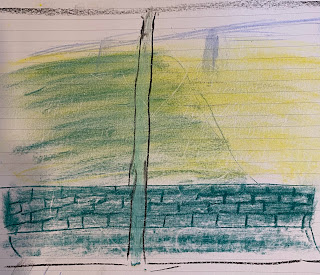
This blog focuses on ways that art, technology, and literacy can interact in all educational settings.
Sunday, April 24, 2022
Thinking about the Future of Conferences

Thursday, April 7, 2022
Finding my way around Fargo North Dakota and other Metacognitive tasks
 This weekend I went to Fargo, North Dakota for an athletic event. Navigating a new city is always a challenge, and I started by activating Google Maps to get everywhere in town. I quickly found out that relying on google maps without any idea about the general direction was a disorienting and challenging experience.
This weekend I went to Fargo, North Dakota for an athletic event. Navigating a new city is always a challenge, and I started by activating Google Maps to get everywhere in town. I quickly found out that relying on google maps without any idea about the general direction was a disorienting and challenging experience.
I find that planning is often missing in students' work. They write an essay, code a program, or create n art product with very little planning. The lack of planning often adds to resistance to editing and revision, which are the keys to moving from a fail to a win. It is hard to get our students to plan, but it is perhaps the most important metacognitive skill that we can teach. Make a plan, execute, iterate, and then reflect. But it all starts with a plan.
The workweek then had a significant planning session led by Kimberley D'Adamo. it was a gratifying experience to start charting the path we want to walk, making sure we feel like we know where we are going and having a reasonable plan to get there.
Tuesday, March 29, 2022
Skill, Digital Creation and memory

Sunday, March 20, 2022
Personal Reflection on Cultural Appropriation and Cowboy Hats

Sunday, March 13, 2022
Clean Your Windows so you can see the fireflies
As I was cleaning, I realized that it was an interesting metaphor that calls on me as a researcher to stop, slow down, and examine what in my process of looking at the world needs cleaning. Is the distortion I see a result of dirt/noise in my control? This can go to weak beliefs and theories that stop me from seeing clearly. It can be unrelated (yet powerful) emotion or just constant activity that prevents me from realizing what I need to be paying attention to.
This may also be true of the devices and apps we use to see the world, algorithms, scanning, and attentional processes obscure what there is to see. Once in a while, we need to stop and clean our windows making sure that we are doing our best to see what is out there. Making what we are seeing is not just the distortion on our window.
This is my Journal page, I noticed that my processing has many more questions than answers or solutions. It could very well be that many of the questions are the ways I am scaffolding my process, or it could be that this early in the research into Art TEAMS, there are questions with answers pending. Leading to one of the only declarations: I have more questions than answers.Saturday, March 5, 2022
So I went to NAEA for the first time
The National Art Education Association meeting was in New York City this spring. Despite many years of being involved in arts integration, I have never had the opportunity to go. This year after our grant application for Art TEAMS was funded Was a great opportunity to go.

Sunday, February 16, 2020
Wikipedia First: New Rules for Online Research
A recent article in Wired revisited how attitudes toward Wikipedia come face to face with the reality of Wikipedia. It is the world's eighth most visited site, it is free, it is not monetized. Students still recite that you cannot get information from Wikipedia- that it is not a reliable site.
In short, there is a gap between what we say "Wikipedia is unreliable, and the information on it cannot be trusted" and the reality that we all use Wikipedia and often for all the right reasons.
 One of the common critiques about Wikipedia is that consensus might not be the best method to determine what is "true." That is a compelling argument and not without merit. It is, however, precisely what researchers do. Send papers to scrutiny "peer review" and research results become "true" when most of the research community thinks they converge, and we reach consensus until new information disrupts it.
One of the common critiques about Wikipedia is that consensus might not be the best method to determine what is "true." That is a compelling argument and not without merit. It is, however, precisely what researchers do. Send papers to scrutiny "peer review" and research results become "true" when most of the research community thinks they converge, and we reach consensus until new information disrupts it.In fact, a whole section of the Conceptual map about the Nature of Science (bottom right in the figure). Has to do with the community.
I will not repeat all the support and critiques of Wikipedia - you can read those on Wired in the original. I would like to instead suggest an addendum to how we treat Wikipedia when we teach students about Information Technology.
Let's make it Wikipedia first, never Wikipedia only. We always need to corroborate any information, but Wikipedia, with its basic information and the next set of links, can launch a search that is not guided just by the commercial and parochial interests of the monetized search engines only.
Wikipedia first





